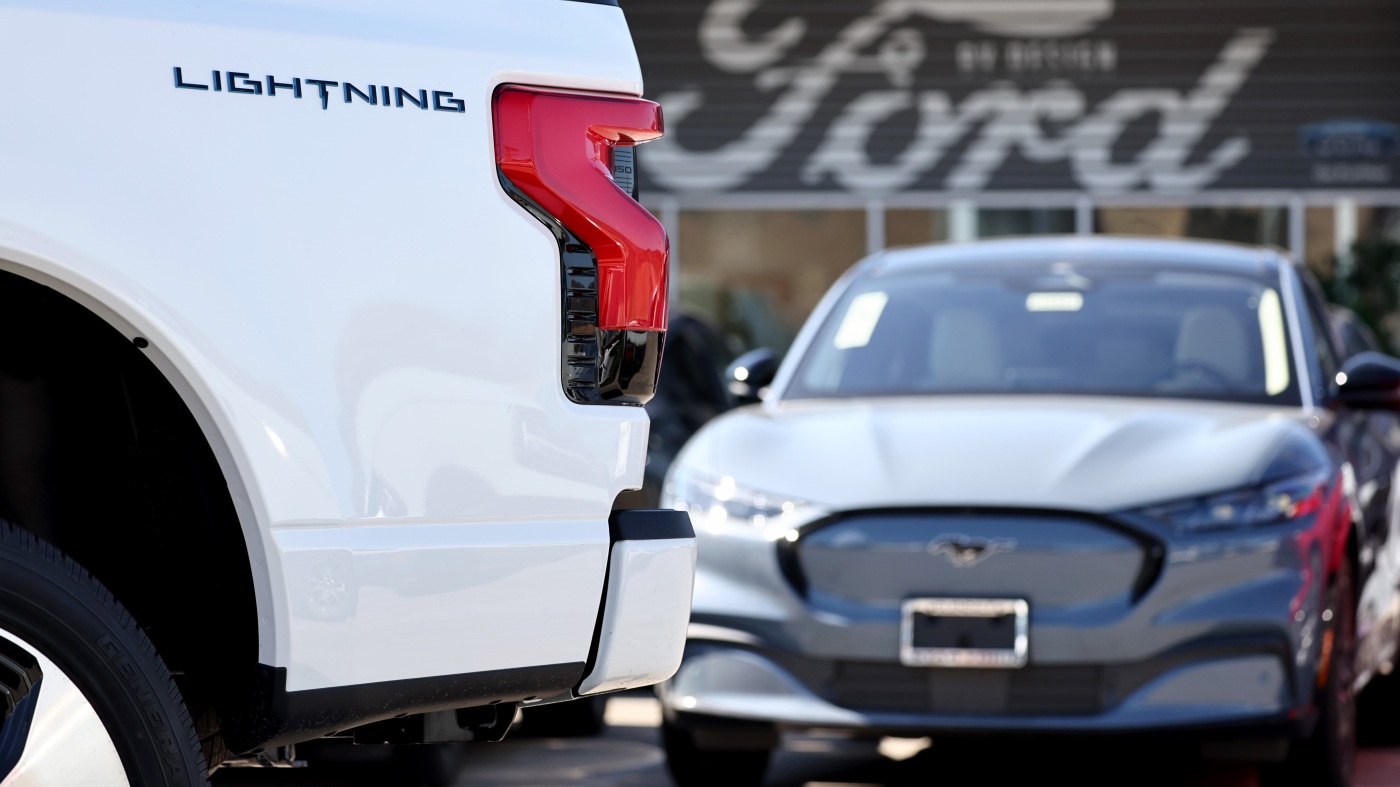A Ford F-150 Lightning electric pickup truck is displayed for sale at a Ford dealership on Aug. 21 in Glendale, Calif. Ford says it is upending its electric vehicle strategy for North American vehicles to focus on hybrids, citing consumers’ demands for affordability and longer ranges.
Mario Tama/Getty Images
hide caption
toggle caption
Mario Tama/Getty Images
If you’re a potential family car customer who’s holding off on buying an electric vehicle because of high prices and road trip anxiety, Ford is thinking about you. In fact, the automaker is hedging its electric vehicle plans, betting that most consumers would rather buy a hybrid than a full EV.
“When you look at the three-row SUV, hybrid technologies or multiple propulsion technologies, for those customers, is the best solution.,” John Lawler, Ford vice chair and chief financial officer, said on Wednesday in a conference call with journalists.
Ford, which is the No. 2 U.S. EV company, had been working to produce an all-electric three-row SUV. But it tapped the brakes on that vehicle earlier this year, and now, Lawler and Ford say, it’s stalled. Instead, Ford will offer hybrid versions of the SUVs. The next EVs in its pipeline are now pickup trucks and commercial vans — areas where Lawler sees a competitive edge.
Ford says all its new vehicles must make a profit in 12 months
The strategic shift reflects Ford’s new requirement for any vehicle to become profitable within 12 months after its launch date — a tall hurdle for an all-electric three-row SUV. Add that to an EV market that’s been cooling on the consumer side even as businesses ramp up their offerings and competitive pressures, and Ford’s leadership saw fit to change course.
“We’re seeing a tremendous amount of competition” in the SUV segment, Lawler said. “In fact, S&P Global … said that there’s about 143 EVs in the pipeline right now for North America — and most of those are two-row and three-row SUVs.”
The change comes as Ford tries to flip the numbers around on EVs. As NPR reported earlier this year, the company has been losing money on every EV it sells. It’s had to scale back sales projections as it prepares for more changes, including an anticipated wave of new Chinese competitors. The company says it’s still working on producing a smaller car, for instance. And it’s moving battery production to North America to let it take advantage of production and consumer incentives.
Spiking the SUV EV comes with a cost: Ford says it will take a “special non-cash charge of about $400 million for the write-down” related to manufacturing assets, with additional expenses possibly rising up to $1.5 billion.
Ford will keep selling its current fully electric vehicles — the Mustang Mach-E and the F-150 Lightning pickup, along with commercial vans. The company isn’t yet saying whether it will offer plug-in hybrid SUVs. But the switch from EV to hybrid SUVs could ease the strain on its bottom line.
It’s all about battery size
“With EVs, it’s all about the battery,” Stephanie Valdez Streaty, director of industry insights at Cox Automotive, told NPR. Depending on the variables, she added, batteries can account for up to 40% to 45% of a vehicle’s cost.
That’s particularly true for a big SUV with long range. For carmakers, shifting from full EV to hybrid offers more wiggle room.
“When you can take down the battery size, whether it’s a plug-in or some type of extended-range type vehicle — on these larger vehicles, like a three-row SUV, the profit profile is better,” Lawler said. “Because … the cost of the battery is so outsized for vehicles like this.”
Streaty says the equation will change a bit as battery technology advances. But she also says consumers may simply need to evaluate how much range they really need — and get used to the idea that a bigger battery means a bigger price tag.
“That’s why I think plug-in hybrids are a good option for consumers who want to go electric, but really need to have that option to [also use] gas if they need to go on a long trip,” she said.
As for the changes announced by Ford, the carmaker isn’t alone in adjusting its plans, Streaty said, noting that GM and Tesla have also seen production cuts.
“There’s still consumer demand,” Streaty said. “We had a record quarter last year for EVs in the U.S., but the pace of growth is slowed down.”
“I think the big thing is, this should be expected. Pure battery electric transition is hard, right?”
Carmakers like Ford, she said, must track a moving target as they try to match consumer demand. That ranges from manufacturing and charging infrastructure to consumers adapting to a different car ownership experience, Streaty said.
“We’re going to have ups and downs,” she said.



